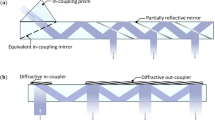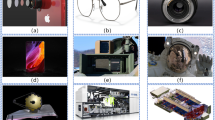Abstract
Stereolithography is one of the most powerful ways to fabricate complex three-dimensional polymeric-based structures layer-by-layer using optical power. Evanescent-wave-based nano-stereolithography using ultra-thin field distribution of evanescent wave to solidify photosensitive resin can provide a sub-micrometer vertical resolution of each layer. To meet strong demands for in-process thickness measurement of cured resin in evanescent-wave-based nano-stereolithography, a measurement method that utilizes variations of resin’s refractive index after polymerization and a high sensitivity of total internal reflection at the critical angle has been proposed. By launching the a measurement light from a substrate to resin at the critical angle and detecting reflections from the resin, slight change in refractive index and thickness of cured resin that have great influences on reflectivity can be in-process measured. This method has been firstly examined by simulation using the rigorous coupled wave analysis method. Here, we show that an increase in cured resin’s thickness induces a decrease in the reflectivity. In experiments, the largest reflectivity contrast between cured and uncured resins has been proved at the critical angle. In addition, the relationship between reflectivity drop and thickness has been calibrated and a linear relationship within a certain thickness range has been experimentally confirmed. Furthermore, the difference of curing process between continuous and discontinuous exposure has been investigated by using the proposed measurement method. At last, image subtraction and a median filter have been applied in imaging processing to remove influences of uneven illumination and background noises.









Similar content being viewed by others
References
Lee JW, Lan PX, Kim B, Lim G, Cho DW (2008) Fabrication and characteristic analysis of a poly(propylene fumarate) scaffold using micro-stereolithography technology. J Biomed Mater Res B Appl Biomater 87(1):1–9
Lee KS, Kim RH, Yang DY, Park SH (2008) Advances in 3D nano/microfabrication using two-photon initiated polymerization. Prog Polym Sci 33(6):631–681
Vaezi M, Seitz H, Yang S (2013) A review on 3D micro-additive manufacturing technologies. Int J Adv Manuf Technol 67(5–8):1721–1754
Cooke MN, Fisher JP, Dean D, Rimnac C, Mikos AG (2003) Use of stereolithography to manufacture critical-sized 3D biodegradable scaffolds for bone ingrowth. J Biomed Mater Res B Appl Biomater 64(2):65–69
Lee KW, Wang SF, Fox BC, Ritman EL, Yaszemski MJ, Lu LC (2007) Poly(propylene fumarate) bone tissue engineering scaffold fabrication using stereolithography:effects of resin formulations and laser parameters. Biomacromolecules 8(4):1077–1084
Griffith ML, Halloran JW (1996) Freeform fabrication of ceramics via stereolithography. J Am Ceram Soc 79(10):2601–2608
Popov VK, Evseev AV, Ivanov AL, Roginski VV, Volozhin AI, Howdle SM (2004) Laser stereolithography and supercritical fluid processing for custom-designed implant fabrication. J Mater Sci Mater Med 15(2):123–128
Hsieh TM, Ng CWB, Narayanan K, Wan AC, Ying JY (2010) Three-dimensional microstructured tissue scaffolds fabricated by two-photon laser scanning photolithography. Biomaterials 31(30):7648–7652
Sun C, Fang N, Wu DM, Zhang X (2005) Projection micro-stereolithography using digital micro-mirror dynamic mask. Sens Actuators A 121(1):113–120
Choi JW, Wicker R, Lee SH, Choi KH, Ha CS, Chung I (2009) Fabrication of 3D biocompatible/biodegradable micro-scaffolds using dynamic mask projection microstereolithography. J Mater Process Technol 209(15):5494–5503
Zhou C, Chen Y, Yang Z, Khoshnevis B (2013) Digital material fabrication using mask-image-projection-based stereolithography. Rapid Prototyp J 19(3):153–165
Ecoffet C, Espanet A, Lougnot DJ (1998) Photopolymerization by evanescent waves: a new method to obtain nanoparts. Adv Mater 10(5):411–414
Takahashi S, Kajihara Y, Takamasu K (2012) Submicrometer thickness layer fabrication for layer-by-layer microstereolithography using evanescent light. CIRP Ann Manuf Technol 61(1):219–222
Suzuki Y, Tahara H, Michihata M, Takamasu K, Takahashi S (2016) Evanescent light exposing system under nitrogen purge for nano-stereolithography. Procedia CIRP 42:77–80
Michihata M, Takamasu K, Takahashi S (2016) Proposal of in-process measurement for micro-stereolithography using surface plasmon resonance. Phys Procedia 83:964–970
Michihata M, Kong D, Takamasu K, Takahashi S (2017) A simulation study of plasmonic substrate for in-process measurement of refractive index in nano-stereolithography. Int J Autom Technol 11(5):772–780
Kong D, Michihata M, Takamasu K, Takahashi S (2017) In-process measurement on the thickness of photosensitive resin in evanescent wave-based nano-stereolithography. In: The 13th international symposium on measurement technology and intelligent instruments, No. 17
Kong D, Michihata M, Takamasu K, Takahashi S (2017) Monitor resin’s curing degree for in-process measurement in micro-stereolithography. In: The 7th international conference of Asian society for precision engineering and nanotechnology, MET-0-08
Beuermann S, Buback M, Davis TP, Gilbert RG, Hutchinson RA, Olaj OF, van Herk AM (1997) Critically evaluated rate coefficients for free-radical polymerization, 2. Propagation rate coefficients for methyl methacrylate. Macromol Chem Phys 198(5):1545–1560
Rueggeberg FA, Margeson DH (1990) The effect of oxygen inhibition on an unfilled/filled composite system. J Dent Res 69(10):1652–1658
Andrzejewska E, Andrzejewski M (1998) Polymerization kinetics of photocurable acrylic resins. J Polym Sci Part A Polym Chem 36(4):665–673
Kaur M, Srivastava AK (2002) Photopolymerization: a review. J Macromol Sci Part C Polym Rev 42(4):481–512
Watts DC, Marouf AS, Al-Hindi AM (2003) Photo-polymerization shrinkage-stress kinetics in resin-composites: methods development. Dent Mater 19(1):1–11
Esposito Corcione C, Greco A, Maffezzoli A (2004) Photopolymerization kinetics of an epoxy based resin for stereolithography. J Appl Polym Sci 92(6):3484–3491
Chiou BS, Khan SA (1997) Real-time FTIR and in situ rheological studies on the UV curing kinetics of thiol-ene polymers. Macromolecules 30(23):7322–7328
Salmoria GV, Klauss P, Pires ATN, Roeder J, Soldi V (2008) Investigations on cure kinetics and thermal degradation of stereolithography Renshape™ 5260 photosensitive resin. Polym Test 27(6):698–704
Subramanian K, Krishnasamy V, Nanjundan S, Reddy AR (2000) Photosensitive polymer: synthesis, characterization and properties of a polymer having pendant photocrosslinkable group. Eur Polymer J 36(11):2343–2350
Fuh JYH, Lu L, Tan CC, Shen ZX, Chew S (1999) Processing and characterising photo-sensitive polymer in the rapid prototyping process. J Mater Process Technol 89:211–217
Brockman JM, Nelson BP, Corn RM (2000) Surface plasmon resonance imaging measurements of ultrathin organic films. Annu Rev Phys Chem 51(1):41–63
Homola J (2008) Surface plasmon resonance sensors for detection of chemical and biological species. Chem Rev 108(2):462–493
Alkaisi MM, Blaikie RJ, McNab SJ, Cheung R, Cumming DRS (1999) Sub-diffraction-limited patterning using evanescent near-field optical lithography. Appl Phys Lett 75(22):3560–3562
Schneider LFJ, Pfeifer CS, Consani S, Prahl SA, Ferracane JL (2008) Influence of photoinitiator type on the rate of polymerization, degree of conversion, hardness and yellowing of dental resin composites. Dent Mater 24(9):1169–1177
Andrzejewska E (2001) Photopolymerization kinetics of multifunctional monomers. Prog Polym Sci 26(4):605–665
De Boer J, Visser RJ, Melis GP (1992) Time-resolved determination of volume shrinkage and refractive index change of thin polymer films during photopolymerization. Polymer 33(6):1123–1126
Langer G, Kavc T, Kern W, Kranzelbinder G, Toussaere E (2001) Refractive index changes in polymers induced by deep UV irradiation and subsequent gas phase modification. Macromol Chem Phys 202(18):3459–3467
Fujita K, Nishiyama N, Nemoto K, Okada T, Ikemi T (2005) Effect of base monomer’s refractive index on curing depth and polymerization conversion of photo-cured resin composites. Dent Mater J 24(3):403–408
Howard B, Wilson ND, Newman SM, Pfeifer CS, Stansbury JW (2010) Relationships between conversion, temperature and optical properties during composite photopolymerization. Acta Biomater 6(6):2053–2059
Author information
Authors and Affiliations
Corresponding author
Rights and permissions
About this article
Cite this article
Kong, D., Michihata, M., Takamasu, K. et al. In-Process Measurement of Thickness of Cured Resin in Evanescent-Wave-Based Nano-stereolithography Using Critical Angle Reflection. Nanomanuf Metrol 1, 112–124 (2018). https://doi.org/10.1007/s41871-018-0013-z
Received:
Accepted:
Published:
Issue Date:
DOI: https://doi.org/10.1007/s41871-018-0013-z




